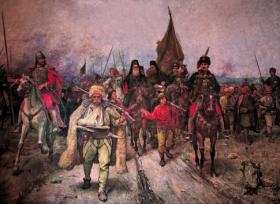Paja Jovanović
Died: Vienna, 30 November 1957
Nationality: Serbian
son of photographer Stefan Jovanović
with Christian Griepenkerl at Vienna Academy (1877-80)
1882 - awarded Vienna Academy prize, including Emperor's Scholarship for The Wounded Montenegrin
1883 - hired by London gallery 'French' to travel in North Africa and Eastern Mediterranean and to send back ethnographic paintings
1893 - elected member of Serbian Royal Academy
1896 - exhibits VršacTriptych at Millenial Exhibition (Budapest)
1900 - exhibits The Proclamation of Dušan's Law at Exposition universelle (Paris)
1905 - begins focusing on portrait painting; moves to Vienna
Travels
Vienna (1877-80; 1905-57); North Africa and Eastern Mediterranean (1883 ff)
Serbian patriarchate; Serbian royal family (portraits); Church of the Translation of the Relics of St Nikolas, Dolovo and Saborna Church in Novi Sad (painted their iconostases); cathedral of Srmeski Karlovci (wall frescoes)
The Wounded Montenegrin, 1882 (Vršac Museum, Serbia)
Vršac Triptych, 1896 (Vršac Museum, Serbia)
The Wedding of Stefan Dušan, 1904 (Vršac Museum, Serbia)
Documentation:
Jelena Milojkovic-Djuric notes the importance of Jovanović:
“Paja Jovanović was acclaimed as the dean of Serbian historical painters and recognized by art critics from major European cities. His first historical composition The Serbian Emigration under Arsenije III Crnojević enjoyed great popularity. The painting was commissioned by the Serbian patriarch Georgije Branković for the Millenium Exhibit commemorating one thousand years of the Hungarian state and pointed out the exceptional position granted to the Serbian population in Austria-Hungary for military assistance. Reproductions of the first variant of this painting later appeared in virtually all Serbian periodicals and were followed by color lithographs. Jovanović’s composition was exhibited in the patriarch’s palace in 1896. This exhibit quickly became a significant cultural event. The unique contributions of Jovanović, as well as of [Jovan] Skerlić *and [Stevan] Mokranjac,** have not been considered in interdependence, as part of the spiritual climate of their time.
Skerlić, Mokranjac, and Jovanović, as proponants of revived national entity, were at the same time creators of ideological consciousness at the time of cultural, social, and political transformations designated to unify southern Slavs.“
* Jovan Skerlić (1877-1914) was a Serbian writer and critic.
**Stevan Mokranjac (1856-1914) was a Serbian composer whose works were influence by folk and religious songs.
Jelena Milojkovic-Djuric, "The Roles of Jovan Skerlic, Steven Mokranjac, and Paja Jovanovic in Serbian Cultural History, 1900-1914,“ Slavic Review, vol. 47, no. 4 (Winter 1988): 687-8.


 Buy the Book
Buy the Book